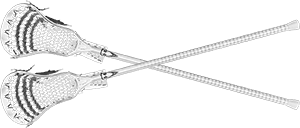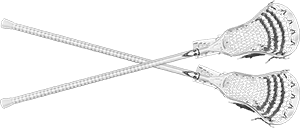About the S.M.L.A.
While the origins of the game of Lacrosse is attributed to the First Nations people of Canada more than three hundred years ago, the first records of the modern game date back to the early 1800’s. This popular sport has grown significantly since then and is now recognized as Canada’s national summer sport with minor associations everywhere across the country.
The Shuswap Minor Lacrosse Association filed its constitution and by-laws in 1996, and since then has fielded teams annually of boys and girls between the ages of 6 and 17.
While our Shuswap Association is not as large as some of our neighbouring associations (we typically have an annual registration between 70 and 90 players throughout all divisions), we continually field teams which are eager and competitive in their league and tournament games. We enjoy the assistance of a dedicated group of parents, coaches and directors in the Shuswap region (Salmon Arm, Enderby, Sicamous and Sorrento areas) who promote and grow this exciting sport.
Shuswap Minor Lacrosse plays Box and Field Lacrosse. Box Lacrosse is played on a standard sized arena floor and features 6 players (goaltender and five runners) on the floor at one time. Our season runs from late March to mid-June with practices and league games during this period. Practices and games are held in Enderby and Salmon Arm. The season begins in Enderby, and once the ice has been removed from Shaw Centre in Salmon Arm, we move to this location.
Box Lacrosse is an exciting event which combines speed, physical condition, coordination and team work together in a physically challenging sport. The combination of action and reaction makes Box as much fun to watch as it is to play. We hope that you develop a love of this sport as we have and try it out.
About Lacrosse
Lacrosse, referred to by the First Nations as the “Creator’s Game” and considered to be North America’s first sport, was born of the First Nations, christened by the French, and adapted and raised by the Canadians. Modern lacrosse has been embraced by athletes and enthusiasts of the United States and the British Commonwealth for over a century.
The sport of lacrosse is a combination of basketball, soccer and hockey. Anyone can play lacrosse whether you’re big or small. The game requires and rewards coordination and agility, not brawn. Quickness and speed are two highly prized qualities in lacrosse.
An exhilarating sport, lacrosse is fast-paced and full of action with abrupt starts and stops, precision passes and quick shots are routine in men’s and women’s lacrosse. Lacrosse is played with a stick, the “crosse”, which must be mastered by the player to throw, catch and scoop the ball.
The evolution of the Native American game into modern lacrosse began in 1636 when Jean de Brebeuf, a Jesuit missionary, documented a Huron contest in what is now southeast Ontario, Canada. At that time, some type of lacrosse was played by at least 48 Native American tribes scattered throughout what is now southern Canada and all parts of the United States. French pioneers began playing the game avidly in the 1800s. Canadian dentist, W. George Beers, standardized the game in 1867 with the adoption of set field dimensions, limits to the number of players per team and other basic rules.
The Canadian Lacrosse Association, established in 1867, adopted Beers’ rules. The same year, a team from Kahnawake, near Montreal, went to England and played a game for Queen Victoria. The sport quickly became popular in such locales as Bristol, London, Cheshire, Lancashire, Manchester, and Yorkshire. The English Lacrosse Union was organized in 1892. Today, lacrosse is played in two distinct versions: Box Lacrosse and Field Lacrosse.
Box lacrosse began in the 1930s as an opportunity to use arenas during the hockey off-season. Box is played indoors in a 6-on-6 format (1 goalie, 5 runners). Box lacrosse is physical and dynamic and in many ways closely resembles hockey. Box lacrosse is very popular in Canada where hockey players use Box to develop their hockey skills. Box is a very creative game that requires strength and agility.
Field lacrosse is played outdoors in a 10-on-10 format (1 goalie, 3 defenders, 3 midfielders, 3 attackers). It is a great game for both boys and girls of both athleticism and skill. Field lacrosse most closely resembles the original First Nations game. It is much less physical than box lacrosse.
Today, lacrosse is played throughout the country with the Mann Cup representing the pinnacle of Canadian Box Lacrosse. The National Lacrosse League (box lacrosse) and Major League Lacrosse (field lacrosse) are professional leagues that are played in front of thousands of fans.
Box Lacrosse & Field Lacrosse
Box Lacrosse
Box Lacrosse is primarily played in Canada but quickly spreading throughout the United States. It is played on a standard sized arena floor and features 6 players (goaltender and five runners) on the floor at one time. Standard goal size is 4′ by 4′. The style of the game is quick, accelerated by the close confines of the floor and a shot clock. The shot clock requires the attacking team to take a shot on goal within 30 seconds of gaining possession of the ball. Box lacrosse is also a much more physical game then field lacrosse. Since cross checking is legal in box lacrosse, players wear rib pads in addition to the shoulder and elbow pads that field lacrosse players wear. Box lacrosse players wear a different type of helmet as well, a hockey helmet with a box lacrosse cage.
Practices and games are held in Enderby and Salmon Arm. The season runs from March to June and begins in Enderby and once the ice has been removed from Shaw Center, in Salmon Arm, we move to this location.
Field Lacrosse
Field Lacrosse is typically played on a field 100 m long and 55 m wide. There are ten players in each team: three attackers, three midfielders, three defenders, and one goalie. Defensive and Offensive players may not pass the center line, however Midfielders or “Middies” are allowed anywhere on the field and may play offense and defense. The goals are 6 feet by 6 feet and sit inside a circular “crease”, measuring 18 feet in diameter. A maximum of four players on the field per team may carry a “long crosse” (sometimes called “long pole”, “long stick” or “d-pole”) which is 52 inches to 72 inches long; typically used by defenders or midfielders.
The Shuswap Minor Lacrosse Association has been hosting Field Lacrosse divisions for 3 seasons in Salmon Arm. The season runs from August to November and games are played on Sundays at various locations throughout the Interior. These Field teams have really helped to improve the quality of play for Box.
 Shuswap Minor Lacrosse Association
Shuswap Minor Lacrosse Association 

